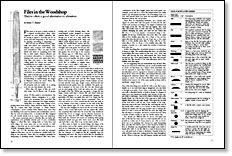Files in the Woodshop
They're often a good alternative to abrasives
Synopsis: You may not consider a file a precision tool, but Henry T. Kramer has brought the badly hogged sole of a 22-in. jointer plane to within +-0.00125 in. of dead flat with only three files. In this article, he discusses 10 groups of “American Pattern” files, or about 170 files useful to woodworkers. He explains their history, how they differ, terms commonly used to describe files, and which ones are best to use on wood. The first thing you should do with a new file, he says, is put a handle on it. He explains how to use files and how to care for them and clean them. A side treatise by Dick Burrows talks about a catalog that describes files and rasps that meet the needs of every specialized trade and industry — including slicing bread.
Files seem to be poor country cousins in a typical woodworker’s shop, often neglected by even skilled craftsmen. But it’s wrong to ignore a tool that can be so useful and that frequently is the best tool for shaping, smoothing or sharpening.
Files can true up all kinds of tools, especially new planes and spokeshaves. They sharpen saws, scrapers, cold chisels, axes and screwdrivers. Files can also smooth knicks and dents in everything from drill bits to drive shafts. They’re efficient and economical alternatives to abrasives for shaping both wood and metal—they last a long time, and there’s a size, shape and cutting grade for almost any carving or smoothing job you might encounter.
You may not consider a file a precision tool, but I’ve brought the badly hogged sole of a 22-in. jointer plane to within ±0.00125 in. of dead flat with only three files. And it doesn’t take as much time or experience as you might think. As in any woodworking or metalworking, the slogan is “Measure twice, cut once.” Stress the word “cut”: you’ll never learn how to use a file properly until you realize it’s a cutting tool, not one that abrades the work.
More than 650 types of files are available today, but I’ll discuss only 10 groups of “American Pattern” files that include about 170 files useful to woodworkers. The American Pattern designation is a traditional one stemming from post-Civil War days when Americans first began manufacturing files on a large scale, instead of importing them from Europe. These American Pattern files usually are coarser than their European or “Swiss Pattern” counterparts. I won’t consider Swiss Patterns here, since they are finishing tools used by jewelers and modelmakers and too fine for most woodshop jobs, or circular-tooth files designed for soft, ductile metals such as copper, brass and aluminum.
The terms commonly used to describe files are fairly selfexplanatory and probably already part of your vocabulary (figure 1). Most files have cutting teeth on both faces and both edges, but some have one or two smooth or “safe” edges so that they can be used in tight corners without accidentally damaging adjacent areas.
The “cut” of a file describes how its teeth are arranged. Single-cut files have one set of continuous, parallel teeth running in one direction. These files are designed primarily for sharpening or finishing metals. Double-cut files have intersecting sets of teeth forming sharp, diamond-shaped points designed to remove material faster. They’ll cut wood quickly, though not as fast as a rasp, which has freestanding, clog-resistant teeth. Rasps and rifflers (small shaped rasps) are made primarily for woodworkers, carvers and farriers. Rasps come in several combinations of length and tooth grade, but all you really have to know is that in similar lengths and grades, the wood rasp is the coarsest, the cabinet rasp is a little finer, and the patternmakers’ cabinet rasp is the finest.
From Fine Woodworking #46
For the full article, download the PDF below:
Fine Woodworking Recommended Products

Veritas Wheel Marking Gauge

Veritas Precision Square

Suizan Japanese Pull Saw





















Log in or create an account to post a comment.
Sign up Log in